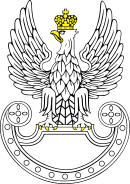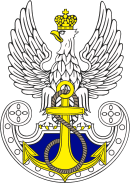Battle of Grunwald
The Battle of Grunwald, Battle of Žalgiris or First Battle of Tannenberg was fought on 15 July 1410 during the Polish–Lithuanian–Teutonic War. The alliance of the Crown of the Kingdom of Poland and the Grand Duchy of Lithuania, led respectively by King Władysław II Jagiełło (Jogaila) and Grand Duke Vytautas, decisively defeated the German–Prussian Teutonic Knights, led by Grand Master Ulrich von Jungingen. Most of the Teutonic Knights' leadership were killed or taken prisoner. Although defeated, the Teutonic Knights withstood the siege of their fortress in Marienburg (Malbork) and suffered minimal territorial losses at the Peace of Thorn (1411) (Toruń), with other territorial disputes continuing until the Peace of Melno in 1422. The knights, however, would never recover their former power, and the financial burden of war reparations caused internal conflicts and an economic downturn in the lands under their control. The battle shifted the balance of power in Central and Eastern Europe and marked the rise of the Polish–Lithuanian union as the dominant political and military force in the region.[8]
The battle was one of the largest in medieval Europe and is regarded as one of the most important victories in the histories of Poland and Lithuania and is also widely celebrated in Belarus.[9] It has been used as a source of romantic legends and national pride, becoming a larger symbol of struggle against foreign invaders.[10] During the 20th century, the battle was used in Nazi German and Soviet propaganda campaigns. Only in recent decades have historians moved towards a dispassionate, scholarly assessment of the battle, reconciling the previous narratives, which differed widely by nation.
Names and sources
Names
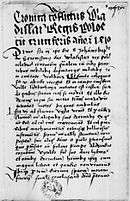
The battle was fought in the territory of the monastic state of the Teutonic Order, on the plains between three villages: Grünfelde (Grunwald) to the west, Tannenberg (Stębark) to the northeast and Ludwigsdorf (Łodwigowo, Ludwikowice) to the south. Władysław II Jagiełło referred to the site in Latin as in loco conflictus nostri, quem cum Cruciferis de Prusia habuimus, dicto Grunenvelt.[8] Later, Polish chroniclers interpreted the word Grunenvelt as Grünwald, meaning "green forest" in German. The Lithuanians followed suit and translated the name as Žalgiris.[12] The Germans named the battle after Tannenberg ("fir hill" or "pine hill" in German).[13] Thus, there are three commonly used names for the battle: German: Schlacht bei Tannenberg, Polish: bitwa pod Grunwaldem, Lithuanian: Žalgirio mūšis. Its names in the languages of other involved peoples include Belarusian: Бітва пад Грунвальдам, Ukrainian: Грюнвальдська битва, Russian: Грюнвальдская битва, Czech: Bitva u Grunvaldu, Romanian: Bătălia de la Grünwald.
Sources
There are few contemporary, reliable sources about the battle, and most were produced by Polish sources. The most important and trustworthy source is Cronica conflictus Wladislai regis Poloniae cum Cruciferis anno Christi 1410, which was written within a year of the battle by an eyewitness.[14] Its authorship is uncertain, but several candidates have been proposed: Polish deputy chancellor Mikołaj Trąba and Władysław II Jagiełło's secretary Zbigniew Oleśnicki.[15] While the original Cronica conflictus did not survive, a short summary from the 16th century has been preserved. Another important source is Historiae Polonicae by Polish historian Jan Długosz (1415–1480).[15] It is a comprehensive and detailed account written several decades after the battle. The reliability of this source suffers not only from the long gap between the events and the chronicle, but also Długosz's alleged biases against the Lithuanians.[16] Banderia Prutenorum is a mid-15th-century manuscript with images and Latin descriptions of the Teutonic battle flags captured during the battle and displayed in Wawel Cathedral and Vilnius Cathedral. Other Polish sources include two letters written by Władysław II Jagiełło to his wife Anne of Cilli and Bishop of Poznań Wojciech Jastrzębiec and letters sent by Jastrzębiec to Poles in the Holy See.[16] German sources include a concise account in the chronicle of Johann von Posilge. A recently discovered anonymous letter, written between 1411 and 1413, provided important details on Lithuanian maneuvers.[17][18]
Historical background
Lithuanian Crusade and Polish–Lithuanian union
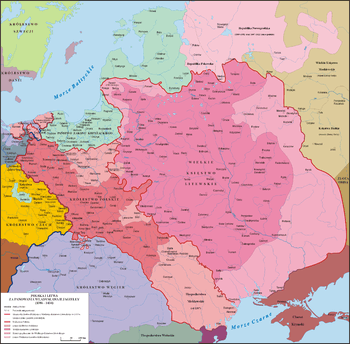
In 1230, the Teutonic Knights, a crusading military order, moved to Chełmno Land and launched the Prussian Crusade against the pagan Prussian clans. With support from the pope and Holy Roman Emperor, the Teutons conquered and converted the Prussians by the 1280s and shifted their attention to the pagan Grand Duchy of Lithuania. For about 100 years the Knights raided Lithuanian lands, particularly Samogitia, as it separated the Knights in Prussia from their branch in Livonia. While the border regions became an uninhabited wilderness, the Knights gained very little territory. The Lithuanians first gave up Samogitia during the Lithuanian Civil War (1381–84) in the Treaty of Dubysa. The territory was used as a bargaining chip to ensure Teutonic support for one of the sides in the internal power struggle.
In 1385, Grand Duke Jogaila of Lithuania agreed to marry Queen Jadwiga of Poland in the Union of Kreva. Jogaila converted to Christianity and was crowned King of Poland (Władysław II Jagiełło), thus creating a personal union between the Kingdom of Poland and the Grand Duchy of Lithuania. The official Lithuanian conversion to Christianity removed the religious rationale for the order's activities in the area.[19] Its grand master, Conrad Zöllner von Rothenstein, supported by Hungarian King Sigismund of Luxemburg, responded by publicly contesting the sincerity of Jogaila's conversion, bringing the charge to a papal court.[19] The territorial disputes continued over Samogitia, which had been in Teutonic hands since the Peace of Raciąż in 1404. Poland also had territorial claims against the Knights in Dobrzyń Land and Gdańsk (Danzig), but the two states had been largely at peace since the Treaty of Kalisz (1343).[20] The conflict was also motivated by trade considerations: The knights controlled the lower reaches of the three largest rivers (the Neman, Vistula and Daugava) in Poland and Lithuania.[21]
War, truce and preparations
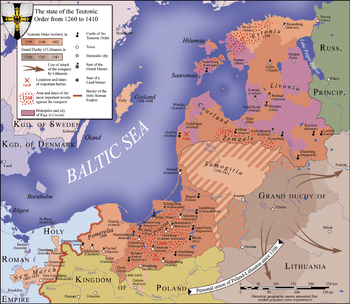
.jpg)
In May 1409, an uprising in Teutonic-held Samogitia started. Lithuania supported it and the knights threatened to invade. Poland announced its support for the Lithuanian cause and threatened to invade Prussia in return. As Prussian troops evacuated Samogitia, Teutonic Grand Master Ulrich von Jungingen declared war on the Kingdom of Poland and the Grand Duchy of Lithuania on 6 August 1409.[22] The Knights hoped to defeat Poland and Lithuania separately, and began by invading Greater Poland and Kuyavia, catching the Poles by surprise.[23] The Knights burned the castle at Dobrin (Dobrzyń nad Wisłą), captured Bobrowniki after a 14-day siege, conquered Bydgoszcz (Bromberg) and sacked several towns.[24] The Poles organized counterattacks and recaptured Bydgoszcz.[25] The Samogitians attacked Memel (Klaipėda).[23] However, neither side was ready for a full-scale war.
Wenceslaus, King of the Romans, agreed to mediate the dispute. A truce was signed on 8 October 1409 and was set to expire on 24 June 1410.[26] Both sides used this time to prepare for war, gathering troops and engaging in diplomatic maneuvering. Both sides sent letters and envoys accusing each other of various wrongdoings and threats to Christendom. Wenceslaus, who received a gift of 60,000 florins from the knights, declared that Samogitia rightfully belonged to the knights and only Dobrzyń Land should be returned to Poland.[27] The knights also paid 300,000 ducats to Sigismund of Hungary, who had ambitions regarding the Principality of Moldavia, for mutual military assistance.[27] Sigismund attempted to break the Polish–Lithuanian alliance by offering Vytautas a king's crown; Vytautas' acceptance would have violated the terms of the Ostrów Agreement and created Polish-Lithuanian discord.[28] At the same time, Vytautas managed to obtain a truce from the Livonian Order.[29]
By December 1409, Władysław II Jagiełło and Vytautas had agreed on a common strategy: their armies would unite into a single massive force and march together towards Marienburg (Malbork), capital of the Teutonic Knights.[30] The Knights, who took a defensive position, did not expect a joint attack and were preparing for a dual invasion—by the Poles along the Vistula River towards Danzig (Gdańsk) and the Lithuanians along the Neman River towards Ragnit (Neman).[1] To counter this perceived threat, Ulrich von Jungingen concentrated his forces in Schwetz (Świecie), a central location from where troops could respond to an invasion from any direction rather quickly.[31] Sizable garrisons were left in the eastern castles of Ragnit, Rhein (Ryn) near Lötzen (Giżycko) and Memel (Klaipėda).[1] To keep their plans secret and mislead the knights, Władysław II Jagiełło and Vytautas organized several raids into border territories, thus forcing the knights to keep their troops in place.[30]
Opposing forces
| Historian | Polish | Lithuanian | Teutonic |
|---|---|---|---|
| Karl Heveker and Hans Delbrück[32] | 10,500 | 6,000 | 11,000 |
| Eugene Razin[33] | 16,000–17,000 | 11,000 | |
| Max Oehler | 23,000 | 15,000 | |
| Jerzy Ochmański | 22,000–27,000 | 12,000 | |
| Sven Ekdahl[32] | 20,000–25,000 | 12,000–15,000 | |
| Andrzej Nadolski | 20,000 | 10,000 | 15,000 |
| Jan Dąbrowski | 15,000–18,000 | 8,000–11,000 | 19,000 |
| Zigmantas Kiaupa[34] | 18,000 | 11,000 | 15,000–21,000 |
| Marian Biskup | 19,000–20,000 | 10,000–11,000 | 21,000 |
| Daniel Stone[19] | 27,000 | 11,000 | 21,000 |
| Stefan Kuczyński | 39,000 | 27,000 | |
| James Westfall Thompson and Edgar Nathaniel Johnson[35] |
100,000 | 35,000 | |
| Alfred Nicolas Rambaud[36] | 163,000 | 86,000 | |
The precise number of soldiers involved has proven difficult to establish.[37] None of the contemporary sources provided reliable troop counts. Jan Długosz provided the number of banners, the principal unit of each cavalry: 51 for the knights, 50 for the Poles and 40 for the Lithuanians.[38] However, it is unclear how many men were under each banner. The structure and number of infantry units (pikemen, archers, crossbowmen) and artillery units is unknown. Estimates, often biased by political and nationalistic considerations, were produced by various historians.[37] German historians tend to present lower numbers, while Polish historians tend to use higher estimates.[6] The high-end estimates by Polish historian Stefan Kuczyński of 39,000 Polish–Lithuanian and 27,000 Teutonic men[38] have been cited in Western literature as "commonly accepted".[5][10][37]
While less numerous, the Teutonic army had advantages in discipline, military training and equipment.[33] They were particularly noted for their heavy cavalry. The Teutonic army was also equipped with bombards that could shoot lead and stone projectiles.[33] Both forces were composed of troops from several states and lands, including numerous mercenaries; for example, Bohemian mercenaries fought on each side.[39] The knights also invited guest crusaders. Twenty-two different peoples, mostly Germanic, joined them.[40] Teutonic recruits included soldiers from Westphalia, Frisia, Austria, Swabia[39] and Stettin (Szczecin).[41] Two Hungarian nobles, Nicholas II Garay and Stibor of Stiboricz, brought 200 men for the Knights,[42] but support from Sigismund of Hungary was disappointing.[29]
Poland brought mercenaries from Moravia and Bohemia. The Czechs produced two full banners, under the command of Jan Sokol z Lamberka (cz).[4] Serving among the Czechs was possibly Jan Žižka, future commander of the Hussite forces.[43] Alexander the Good, ruler of Moldavia, commanded an expeditionary corps.[2] Vytautas gathered troops from Lithuanian, Ruthenian (modern Belarus and Ukraine) and Russian lands. The three Russian banners from Smolensk were under the command of Władysław II Jagiełło's brother Lengvenis, while the contingent of Tatars of the Golden Horde was under the command of the future Khan Jalal ad-Din.[3] The overall commander of the joint Polish–Lithuanian force was King Władysław II Jagiełło; however, he did not directly participate in the battle. The Lithuanian units were commanded directly by Grand Duke Vytautas, who was second in command, and helped design the grand strategy of the campaign. Vytautas actively participated in the battle, managing both Lithuanian and Polish units.[44] Jan Długosz stated that the low-ranking sword bearer of the Crown, Zyndram of Maszkowice, commanded the Polish army, but that is highly doubtful.[45] More likely, marshal of the Crown Zbigniew of Brzezie commanded the Polish troops in the field.
Course of the battle
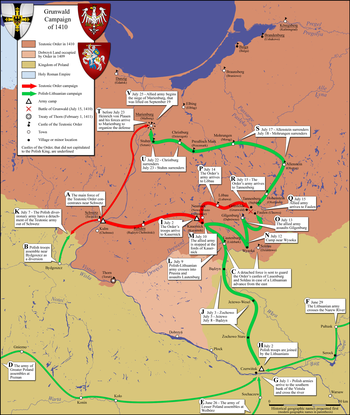
March into Prussia
The first stage of the Grunwald campaign was the gathering of all Polish–Lithuanian troops at Czerwinsk, a designated meeting point about 80 km (50 mi) from the Prussian border, where the joint army crossed the Vistula over a pontoon bridge.[46] This maneuver, which required precision and intense coordination among multi-ethnic forces, was accomplished in about a week, from 24–30 June.[1] Polish soldiers from Greater Poland gathered in Poznań, and those from Lesser Poland, in Wolbórz. On 24 June, Władysław II Jagiełło and Czech mercenaries arrived in Wolbórz.[1] Three days later the Polish army was already at the meeting place. The Lithuanian army marched out from Vilnius on 3 June and joined the Ruthenian regiments in Hrodna.[1] They arrived in Czerwinsk on the same day the Poles crossed the river. After the crossing, Masovian troops under Siemowit IV and Janusz I joined the Polish–Lithuanian army.[1] The massive force began its march north towards Marienburg (Malbork), capital of Prussia, on 3 July. The Prussian border was crossed on 9 July.[46]
The river crossing remained secret until Hungarian envoys, who were attempting to negotiate a peace, informed the Grand Master.[47] As soon as Ulrich von Jungingen grasped the Polish–Lithuanian intentions, he left 3,000 men at Schwetz (Świecie) under Heinrich von Plauen[48] and marched the main force to organize a line of defense on the Drewenz River (Drwęca) near Kauernik (Kurzętnik).[49] The river crossing was fortified with stockades.[50] On 11 July, after meeting with his eight-member war council,[45] Władysław II Jagiełło decided against crossing the river at such a strong, defensible position. The army would instead bypass the river crossing by turning east, towards its sources, where no other major rivers separated his army from Marienburg.[49] The march continued east towards Soldau (Działdowo), although no attempt was made to capture the town.[51] The Teutonic army followed the Drewenz River north, crossed it near Löbau (Lubawa) and then moved east in parallel with the Polish–Lithuanian army. According to the Order propaganda the latter ravaged the village of Gilgenburg (Dąbrówno).[52] Later, in the self-serving testimonies of the survivors before the Pope the Order claimed that Von Jungingen was so enraged by the alleged atrocities that he swore to defeat the invaders in battle.[53]
Battle preparations

In the early morning of 15 July, both armies met in an area covering approximately 4 km2 (1.5 sq mi) between the villages of Grunwald, Tannenberg (Stębark) and Ludwigsdorf (Łodwigowo).[54] The armies formed opposing lines along a northeast–southwest axis. The Polish–Lithuanian army was positioned in front and east of Ludwigsdorf and Tannenberg.[55] Polish heavy cavalry formed the left flank, Lithuanian light cavalry the right flank and various mercenary troops made up the center. Their men were organized in three lines of wedge-shaped formations about 20 men deep.[55] The Teutonic forces concentrated their elite heavy cavalry, commanded by Grand Marshal Frederic von Wallenrode, against the Lithuanians.[54] The Knights, who were the first to organize their army for the battle, hoped to provoke the Poles or Lithuanians into attacking first. Their troops, wearing heavy armor, had to stand in the scorching sun for several hours waiting for an attack.[56] One chronicle suggested that they had dug pits that an attacking army would fall into.[57] They also attempted to use field artillery, but a light rain dampened their powder and only two cannon shots were fired.[56] As Władysław II Jagiełło delayed, the Grand Master sent messengers with two swords to "assist Władysław II Jagiełło and Vytautas in battle". The swords were meant as an insult and a provocation.[58] Known as the "Grunwald Swords", they became one of the national symbols of Poland.
Battle begins: Lithuanian attack and retreat manoeuvre
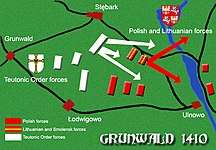 Retreat of Lithuanian light cavalry
Retreat of Lithuanian light cavalry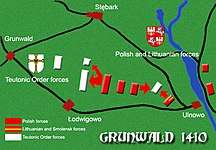 Right-flank Polish–Lithuanian assault
Right-flank Polish–Lithuanian assault Polish heavy cavalry break-through
Polish heavy cavalry break-through
Vytautas, supported by the Polish banners, started an assault on the left flank of the Teutonic forces.[56] After more than an hour of heavy fighting, the Lithuanian light cavalry began a full retreat. Jan Długosz described this development as a complete annihilation of the entire Lithuanian army. According to Długosz, the Knights assumed that victory was theirs, broke their formation for a disorganized pursuit of the retreating Lithuanians, and gathered much loot before returning to the battlefield to face the Polish troops.[59] He made no mention of the Lithuanians, who later returned to the battlefield. Thus, Długosz portrayed the battle as a single-handed Polish victory.[59] This view contradicted Cronica conflictus and has been challenged by modern historians.
Starting with an article by Vaclaw Lastowski in 1909, they proposed that the retreat had been a planned maneuver borrowed from the Golden Horde.[60] A feigned retreat had been used in the Battle of the Vorskla River (1399), when the Lithuanian army had been dealt a crushing defeat and Vytautas himself had barely escaped alive.[61] This theory gained wider acceptance after the discovery and publication, in 1963 by Swedish historian Sven Ekdahl, of a German letter.[62] Written a few years after the battle, it cautioned the new Grand Master to look out for feigned retreats of the kind that had been used in the Great Battle.[18] Stephen Turnbull asserts that the Lithuanian tactical retreat did not quite fit the formula of a feigned retreat; such a retreat was usually staged by one or two units (as opposed to almost an entire army) and was swiftly followed by a counterattack (whereas the Lithuanians had returned late in the battle).[63]
Battle continues: Polish–Teutonic fight

While the Lithuanians were retreating, heavy fighting broke out between Polish and Teutonic forces. Commanded by Grand Komtur Kuno von Lichtenstein, the Teutonic forces concentrated on the Polish right flank. Six of von Walenrode's banners did not pursue the retreating Lithuanians, instead joining the attack on the right flank.[34] A particularly valuable target was the royal banner of Kraków. It seemed that the Knights were gaining the upper hand, and at one point the royal standard-bearer, Marcin of Wrocimowice, lost the Kraków banner.[64] However, it was soon recaptured and fighting continued. Władysław II Jagiełło deployed his reserves—the second line of his army.[34] Grand Master Ulrich von Jungingen then personally led 16 banners, almost a third of the original Teutonic strength, to the right Polish flank,[65] and Władysław II Jagiełło deployed his last reserves, the third line of his army.[34] The melee reached the Polish command and one Knight, identified as Lupold or Diepold of Kökeritz, charged directly against King Władysław II Jagiełło.[66] Władysław's secretary, Zbigniew Oleśnicki, saved the king's life, gaining royal favor and becoming one of the most influential people in Poland.[19]
Battle ends: Teutonic Knights defeated

At that time the reorganized Lithuanians returned to the battle, attacking von Jungingen from the rear.[67] The Teutonic forces were by then becoming outnumbered by the mass of Polish knights and advancing Lithuanian cavalry. As von Jungingen attempted to break through the Lithuanian lines, he was killed.[67] According to Cronica conflictus, Dobiesław of Oleśnica thrust a lance through the Grand Master's neck,[67] while Długosz presented Mszczuj of Skrzynno as the killer. Surrounded and leaderless, the Teutonic Knights began to retreat. Part of the routed units retreated towards their camp. This move backfired when the camp followers turned against their masters and joined the manhunt.[68] The knights attempted to build a wagon fort: The camp was surrounded by wagons serving as an improvised fortification.[68] However, the defense was soon broken and the camp was ravaged. According to Cronica conflictus, more Knights died there than on the battlefield.[68] The battle lasted for about ten hours.[34]
The Teutonic Knights attributed the defeat to treason on the part of Nikolaus von Renys (Mikołaj of Ryńsk), commander of the Culm (Chełmno) banner, and he was beheaded without a trial.[69] He was the founder and leader of the Lizard Union, a group of Knights sympathetic to Poland. According to the Knights, von Renys lowered his banner, which was taken as a signal of surrender and led to the panicked retreat.[70] The legend that the Knights were "stabbed in the back" was echoed in the post-World War I stab-in-the-back legend and preoccupied German historiography of the battle until 1945.[69]
Aftermath
Casualties and captives
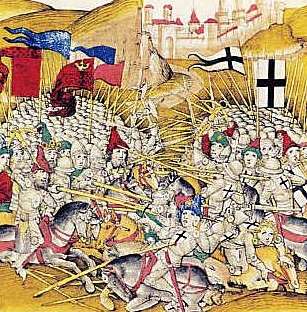
A note sent in August by envoys of King Sigismund of Hungary, Nicholas II Garai and Stibor of Stiboricz, put total casualties at 8,000 dead "on both sides".[71] However, the wording is vague and it is unclear whether it meant a total of 8,000 or 16,000 dead.[72] A papal bull from 1412 mentioned 18,000 dead Christians.[71] In two letters written immediately after the battle, Władysław II Jagiełło mentioned that Polish casualties were small (paucis valde and modico) and Jan Długosz listed only 12 Polish knights that were killed.[71] A letter by a Teutonic official from Tapiau (Gvardeysk) mentioned that only half of the Lithuanians returned, but it is unclear how many of those casualties are attributable to the battle and how many to the later siege of Marienburg.[71]
The defeat of the Teutonic Knights was resounding. According to Teutonic payroll records, only 1,427 men reported back to Marienburg to claim their pay.[73] Of 1,200 men sent from Danzig, only 300 returned.[41] Between 203 and 211 brothers of the Order were killed, out of 270 that participated in battle,[7] including much of the Teutonic leadership—Grand Master Ulrich von Jungingen, Grand Marshal Friedrich von Wallenrode, Grand Komtur Kuno von Lichtenstein, Grand Treasurer Thomas von Merheim, Marshal of Supply Forces Albrecht von Schwartzburg, and ten of the komturs.[74] Markward von Salzbach, Komtur of Brandenburg (Ushakovo) and Heinrich Schaumburg, voigt of Sambia, were executed by order of Vytautas after the battle.[73] The bodies of von Jungingen and other high-ranking officials were transported to Marienburg Castle for burial on 19 July.[75] The bodies of lower-ranking Teutonic officials and 12 Polish knights were buried at the church in Tannenberg.[75] The rest of the dead were buried in several mass graves. The highest-ranking Teutonic official to escape the battle was Werner von Tettinger, Komtur of Elbing (Elbląg).[73]
Polish and Lithuanian forces took several thousand captives. Among these were Dukes Konrad VII of Oels (Oleśnica) and Casimir V of Pomerania.[76] Most of the commoners and mercenaries were released shortly after the battle on condition that they report to Kraków on 11 November 1410.[77] Only those who were expected to pay ransom were kept. Considerable ransoms were recorded; for example, the mercenary Holbracht von Loym had to pay 150 kopas of Prague groschen, amounting to more than 30 kg (66 lb) of silver.[78]
Further campaign and peace
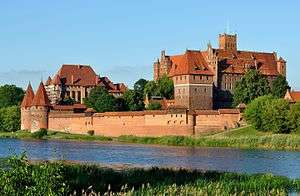
After the battle, the Polish and Lithuanian forces delayed their attack on the Teutonic capital in Marienburg (Malbork), remaining on the battlefield for three days and then marching an average of only about 15 km (9.3 mi) per day.[79] The main forces did not reach heavily fortified Marienburg until 26 July. This delay gave Heinrich von Plauen enough time to organize a defense. Władysław II Jagiełło also sent his troops to other Teutonic fortresses, which often surrendered without resistance,[80] including the major cities of Danzig (Gdańsk), Thorn (Toruń), and Elbing (Elbląg).[81] Only eight castles remained in Teutonic hands.[82] The besiegers of Marienburg expected a speedy capitulation and were not prepared for a long siege, suffering from lack of ammunition, low morale and an epidemic of dysentery.[83] The Knights appealed to their allies for help, and Sigismund of Hungary, Wenceslaus, King of the Romans, and the Livonian Order promised financial aid and reinforcements.[84]
The siege of Marienburg was lifted on 19 September. The Polish–Lithuanian forces left garrisons in the fortresses they had taken and returned home. However, the Knights quickly recaptured most of the castles. By the end of October only four Teutonic castles along the border remained in Polish hands.[85] Władysław II Jagiełło raised a fresh army and dealt another defeat to the Knights in the Battle of Koronowo on 10 October 1410. Following other brief engagements, both sides agreed to negotiate.
The Peace of Thorn was signed in February 1411. Under its terms, the Knights ceded the Dobrin Land (Dobrzyń Land) to Poland and agreed to resign their claims to Samogitia during the lifetimes of Władysław II Jagiełło and Vytautas,[86] although another two wars—the Hunger War of 1414 and the Gollub War of 1422—would be waged before the Treaty of Melno permanently resolved the territorial disputes.[87] The Poles and Lithuanians were unable to translate the military victory into territorial or diplomatic gains. However, the Peace of Thorn imposed a heavy financial burden on the Knights from which they never recovered. They had to pay an indemnity in silver in four annual installments.[86] To meet these payments, the Knights borrowed heavily, confiscated gold and silver from churches and increased taxes. Two major Prussian cities, Danzig (Gdańsk) and Thorn (Toruń), revolted against the tax increases.[88] The defeat at Grunwald left the Teutonic Knights with few forces to defend their remaining territories. Since Samogitia became officially christened, as both Poland and Lithuania were for a long time, the Knights had difficulties recruiting new volunteer crusaders.[89] The Grand Masters then needed to rely on mercenary troops, which proved an expensive drain on their already depleted budget. The internal conflicts, economic decline, and tax increases led to unrest and the foundation of the Prussian Confederation, or Alliance against Lordship, in 1441. This in turn led to a series of conflicts that culminated in the Thirteen Years' War (1454).[90]
Legacy
Poland and Lithuania
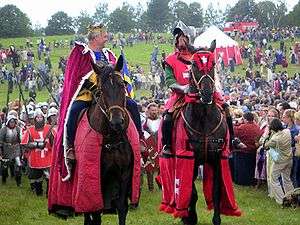
The Battle of Grunwald is regarded as one of the most important in the histories of Poland and Lithuania.[10] In the history of Ukraine, the battle is better associated with Vytautas the Great, who stood as the leader of Eastern Orthodox Christianity at that time.[91] In Lithuania, the victory is synonymous with the Grand Duchy's political and military peak. It was a source of national pride during the age of Romantic nationalism and inspired resistance to the Germanization and Russification policies of the German and Russian Empires. The Knights were portrayed as bloodthirsty invaders and Grunwald as a just victory achieved by a small, oppressed nation.[10]
In 1910, to mark the 500th anniversary of the battle, a monument by Antoni Wiwulski was unveiled in Kraków during a three-day celebration attended by some 150,000 people.[92] About 60 other towns and villages in Galicia also erected Grunwald monuments for the anniversary.[93] The Battle of Grunwald is commemorated on the Tomb of the Unknown Soldier in Warsaw, with the inscription "GRUNWALD 15 VII 1410".
_monument_in_Krakow.jpg)
About the same time, Nobel Prize-winner Henryk Sienkiewicz wrote the novel The Knights of the Cross (Polish: Krzyżacy), prominently featuring the battle in one of the chapters. In 1960, Polish filmmaker Aleksander Ford used the book as the basis for his film, Knights of the Teutonic Order. A museum, monuments and memorials were constructed at the battlefield in 1960.[94] The battle site is one of Poland's official, national Historic Monuments, as designated on 4 October 2010, and tracked by the National Heritage Board of Poland. The battle has lent its name to military decorations (Cross of Grunwald), sports teams (BC Žalgiris, FK Žalgiris), and various organizations.
An annual battle re-enactment takes place on 15 July. In 2010, a pageant reenacting the event and commemorating the battle's 600th anniversary was held. It attracted 200,000 spectators who watched 2,200 participants playing the role of knights in a re-enactment of the battle. An additional 3,800 participants played peasants and camp followers. The pageant's organisers believe that the event has become the largest re-enactment of medieval combat in Europe.[95]
In 2010, the National Bank of Ukraine released a jubilee coin of 20 hryvnia commemorated to the 600 anniversary of the battle. At least three cities in Ukraine (Lviv, Drohobych, and Ivano-Frankivsk) have a street named after the battle.[96][97]
.jpg)
Germany and Russia
Germans generally saw the Knights as heroic and noble men who brought Christianity and civilization to the east, although many came to the region with more material motives.[10] In August 1914, during World War I, Germany won a battle against Russia near the site. When the Germans realized its propaganda potential, they named the battle the Battle of Tannenberg,[98] despite it having actually taken place much closer to Allenstein (Olsztyn), and framed it as revenge for the Polish–Lithuanian victory 504 years earlier. Nazi Germany later exploited the sentiment by portraying their Lebensraum policies as a continuation of the Knights' historical mission.[99]
SS Chief Heinrich Himmler told Nazi Germany's leader Adolf Hitler on the first day of the Warsaw Uprising in August 1944: "After five, six weeks we shall leave. But by then Warsaw, the capital, the head, the intelligence of this former 16–17 million Polish people will be extinguished, this Volk that has blocked our way to the east for 700 years and has stood in our way ever since the First Battle of Tannenberg."[100][101]
Due to the participation of the three Smolensk regiments, Russians saw the battle as a victory of a Polish–Lithuanian–Russian coalition against invading Germans. Chronicler Jan Długosz praised the Smolensk banners, who fought bravely and, according to him, were the only banners from the Grand Duchy of Lithuania not to retreat. In Soviet historiography, the Battle of Grunwald was styled as an ethnic struggle between Slavs and Germanics.[102] The Teutonic Knights were portrayed as the medieval forerunners of Hitler's armies, while the battle itself was seen as the medieval counterpart to the Battle of Stalingrad.[10][102]
In William Urban's summary, almost all accounts of the battle made before the 1960s were more influenced by romantic legends and nationalistic propaganda than by fact.[69] Historians have since made progress towards dispassionate scholarship and reconciliation of the various national accounts of the battle.[99]
In 2014, the Russian Military Historical Society stated that Russian troops and their allies defeated the German knights in the Battle of Grunwald,[103] though evidence that the Grand Duchy of Moscow was involved with this battle is lacking. In July 2017, billboards appeared on the streets of Russian cities with statements that seemed to attribute the victory in the battle of Grunwald to Russia.[104]
References
Notes
- Jučas 2009, p. 75
- Urban 2003, p. 138
- Turnbull 2003, p. 28
- Turnbull 2003, p. 26
- Davies 2005, p. 98
- Jučas 2009, pp. 57–58
- Frost 2015, pp. 106–107
- Ekdahl 2008, p. 175
- Turnbull 2003, p. 92
- Johnson 1996, p. 43
- Jučas 2009, p. 8
- Sužiedėlis 2011, p. 123
- Evans 1970, p. 3
- Jučas 2009, p. 8
- Jučas 2009, p. 9
- Jučas 2009, p. 10
- Jučas 2009, p. 11
- Ekdahl 1963
- Stone 2001, p. 16
- Urban 2003, p. 132
- Kiaupa, Kiaupienė & Kunevičius 2000, p. 137
- Turnbull 2003, p. 20
- Ivinskis 1978, p. 336
- Urban 2003, p. 130
- Kuczynski 1960, p. 614
- Jučas 2009, p. 51
- Turnbull 2003, p. 21
- Kiaupa, Kiaupienė & Kunevičius 2000, p. 139
- Christiansen 1997, p. 227
- Turnbull 2003, p. 30
- Jučas 2009, p. 74
- Frost 2015, p. 106
- Разин 1999, p. 486
- Kiaupa 2002
- Thompson & Johnson 1937, p. 940
- Rambaud 1898
- Turnbull 2003, p. 25
- Ivinskis 1978, p. 338
- Turnbull 2003, p. 29
- Разин 1999, pp. 485–486
- Jučas 2009, p. 56
- Urban 2003, p. 139
- Richter 2010
- Jučas 2009, p. 64
- Jučas 2009, p. 63
- Turnbull 2003, p. 33
- Urban 2003, p. 141
- Urban 2003, p. 142
- Turnbull 2003, p. 35
- Jučas 2009, p. 76
- Turnbull 2003, p. 36
- Turnbull 2003, pp. 36–37
- Urban 2003, pp. 148–149
- Jučas 2009, p. 77
- Turnbull 2003, p. 44
- Turnbull 2003, p. 45
- Urban 2003, p. 149
- Turnbull 2003, p. 43
- Jučas 2009, p. 78
- Baranauskas 2011, p. 25
- Sužiedėlis 1976, p. 337
- Urban 2003, pp. 152–153
- Turnbull 2003, pp. 48–49
- Jučas 2009, p. 83
- Turnbull 2003, p. 53
- Turnbull 2003, p. 61
- Turnbull 2003, p. 64
- Turnbull 2003, p. 66
- Urban 2003, p. 168
- Turnbull 2003, p. 79
- Bumblauskas 2010, p. 74
- Bumblauskas 2010, pp. 74–75
- Turnbull 2003, p. 68
- Jučas 2009, pp. 85–86
- Jučas 2009, p. 87
- Turnbull 2003, p. 69
- Jučas 2009, p. 88
- Pelech 1987, pp. 105–107
- Urban 2003, p. 162
- Urban 2003, p. 164
- Stone 2001, p. 17
- Ivinskis 1978, p. 342
- Turnbull 2003, p. 75
- Turnbull 2003, p. 74
- Urban 2003, p. 166
- Christiansen 1997, p. 228
- Kiaupa, Kiaupienė & Kunevičius 2000, pp. 142–144
- Turnbull 2003, p. 78
- Christiansen 1997, pp. 228–230
- Stone 2001, pp. 17–19
- "Битва народів": 600 Грюнвальдської битви ("Battle of Peoples": 600 Anniversary of the Battle of Grunwald). BBC-Ukraine.
- Dabrowski 2004, pp. 164–165
- Ekdahl 2008, p. 179
- Ekdahl 2008, p. 186
- Fowler 2010
- The holiday of the street (Свято вулиці (відео)). News.IF. 28 July 2010
- Ivasiv, Natalia. The holiday of Hriunvaldska vulytsia (Свято Грюнвальдської вулиці). Zakhidny Kuryer. 15 July 2010.
- Burleigh 1985, p. 27
- Johnson 1996, p. 44
- Wlodzimierz Borodziej: Der Warschauer Aufstand 1944. Fischer, Frankfurt am Main 2004, p. 121.
- Richie, Alexandra (2013). Warsaw 1944: Hitler, Himmler, and the Warsaw Uprising. Farrar, Straus and Giroux. p. 242. ISBN 1466848472.
- Davies 2005, p. 99
- Calendar of memorable dates of military history of Russia. July.
- Победа России в Грюнвальдской битве — новый исторический «факт»
Bibliography
- Baranauskas, Tomas (2011), "Žalgirio mūšis Lietuvos istorikų darbuose" (PDF), Istorija (in Lithuanian), 1 (81), ISSN 1392-0456, archived from the original (PDF) on 4 June 2019, retrieved 4 June 2019
- Bumblauskas, Alfredas (2010), "Žalgiris: neatsakyti klausimai", Lietuvos Istorijos Studijos (in Lithuanian), 26, ISSN 1392-0448
- Burleigh, Michael (June 1985), "The German Knight: Making of A Modern Myth", History Today, 6 (35), ISSN 0018-2753
- Christiansen, Eric (1997), The Northern Crusades (2nd ed.), Penguin Books, ISBN 978-0-14-026653-5
- Dabrowski, Patrice M. (2004), Commemorations and the shaping of modern Poland, Indiana University Press, ISBN 978-0-253-34429-8
- Davies, Norman (2005), God's Playground. A History of Poland. The Origins to 1795, I (Revised ed.), Oxford University Press, ISBN 978-0-19-925339-5
- Ekdahl, Sven (2008), "The Battle of Tannenberg-Grunwald-Žalgiris (1410) as reflected in Twentieth-Century monuments", in Victor Mallia-Milanes (ed.), The Military Orders: History and Heritage, 3, Ashgate Publishing, Ltd., ISBN 978-0-7546-6290-7
- Ekdahl, Sven (1963), "Die Flucht der Litauer in der Schlacht bei Tannenberg", Zeitschrift für Ostforschung (in German), 1 (12), archived from the original on 18 July 2011
- Evans, Geoffrey Charles (1970), Tannenberg, 1410:1914, Hamilton, OCLC 468431737
- Fowler, Jonathan (17 July 2010), Tabards on, visors down: fans relive 1410 Battle of Grunwald, AFP
- Frost, Robert (2015), The Oxford History of Poland-Lithuania: The Making of the Polish-Lithuanian Union 1385–1569, 1, Oxford University Press, ISBN 9780198208693
- Ivinskis, Zenonas (1978), Lietuvos istorija iki Vytauto Didžiojo mirties (in Lithuanian), Rome: Lietuvių katalikų mokslo akademija, OCLC 70309981
- Johnson, Lonnie (1996), Central Europe: Enemies, Neighbors, Friends, Oxford University Press, ISBN 978-0-19-510071-6
- Jučas, Mečislovas (2009), The Battle of Grünwald, Vilnius: National Museum Palace of the Grand Dukes of Lithuania, ISBN 978-609-95074-5-3
- Kiaupa, Zigmantas (2002), "Didysis karas su Kryžiuočiais", Gimtoji istorija. Nuo 7 iki 12 klasės (in Lithuanian), Vilnius: Elektroninės leidybos namai, ISBN 978-9986-9216-9-1, archived from the original on 3 March 2008, retrieved 31 May 2010
- Kiaupa, Zigmantas; Kiaupienė, Jūratė; Kunevičius, Albinas (2000), The History of Lithuania Before 1795, Vilnius: Lithuanian Institute of History, ISBN 978-9986-810-13-1
- Kuczynski, Stephen M. (1960), The Great War with the Teutonic Knights in the years 1409–1411, Ministry of National Defence, OCLC 20499549
- Mickūnaitė, Giedrė (2006), Making a great ruler: Grand Duke Vytautas of Lithuania, Central European University Press, ISBN 978-963-7326-58-5
- Pelech, Markian (1987), "W sprawie okupu za jeńców krzyżackich z Wielkiej Wojny (1409–1411)", Zapiski Historyczne (in Polish), 2 (52), archived from the original on 28 September 2011, retrieved 1 June 2010
- Разин, Е. А. (1999), История военного искусства VI – XVI вв. (in Russian), 2, Издательство Полигон, ISBN 978-5-89173-041-0
- Rambaud, Alfred Nicolas (1898), History of Russia, 1, translated by Leonora B. Lang, New York: Peter Fenelon Collier
- Richter, Jan (16 July 2010), Jan Žižka at Grunwald: from mercenary to Czech national hero, Radio Prague, retrieved 16 August 2012
- Stone, Daniel (2001), The Polish-Lithuanian state, 1386–1795, University of Washington Press, ISBN 978-0-295-98093-5
- Sužiedėlis, Saulius (2011), "Battle of Grunwald", Historical Dictionary of Lithuania (2nd ed.), Scarecrow Press, ISBN 978-0810849143
- Sužiedėlis, Simas, ed. (1976), "Tatars", Encyclopedia Lituanica, V, Boston, Massachusetts: Juozas Kapočius, OCLC 95559
- Thompson, James Westfall; Johnson, Edgar Nathaniel (1937), An Introduction to Medieval Europe, 300–1500, W. W. Norton & Company, Inc., OCLC 19683883
- Turnbull, Stephen (2003), Tannenberg 1410: Disaster for the Teutonic Knights, Campaign Series, 122, London: Osprey, ISBN 978-1-84176-561-7
- Urban, William (2003), Tannenberg and After: Lithuania, Poland and the Teutonic Order in Search of Immortality (Revised ed.), Chicago: Lithuanian Research and Studies Center, ISBN 978-0-929700-25-0
External links
| Wikimedia Commons has media related to Battle of Grunwald. |
| Wikiquote has quotations related to: Battle of Grunwald |
- Cronica conflictus Wladislai regis Poloniae cum cruciferi sanno Christi 1410 (Chronicle of the battle, written in 1410-1411, just after the battle)
- Virtual trip – 360VR panoramic images from Grunwald
- Account by Jan Dlugosz, written sixty years after the battle
- 600th anniversary celebrations in 2010
- Battle of Grunwald re-enactment (every year on 15 July)
- (in Latin) Photos of Banderia Prutenorum, a catalog of captured Teutonic banners
- Festival to mark the 600th anniversary of the Battle of Grunwald in pictures on the official website of Belarus


